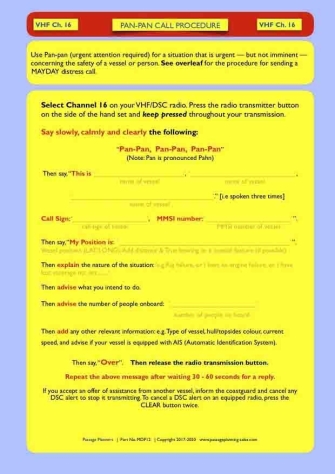Mayday & Pan-Pan Cockpit Cards. How to make a Mayday or Pan-Pan call from your boat!
This is a set of two A4 size plastic heat encapsulated cockpit cards which will be invaluable should you need to make an emergency 'Mayday' or 'Pan-Pan' call. The cards include all the details required to make the Coast Guard or emergency services aware of your emergency.
The Mayday distress call procedure is on one side, and the Pan-Pan call procedure is on the reverse.
Our Radio Emergency Mayday and Pan-Pan cockpit cards takes the user through the spoken Mayday and/or Pan-pan procedure, and each type of distress call is treated separately. The set of forms need to be kept near your VHF or DSC radio either in the cockpit or at the radio station below deck. The essential details such as Vessel Name, Call Sign and MMSI identification number may be filled in by the user so that they will be ready for instant use should the need arise. The procedure can then be read out by the person making the call, in a calm and controlled manner, who may not be the skipper or indeed have any training in making such calls, thereby allowing them to make the call in the correct protocol required by the Coast Guard.
Waterproof and supplied in Matt finish both sides, each card can be written on using a B grade black pencil and easily erased with a rubber eraser. Can be used several times. ✱ (Supplied as 2 pages in 1 encapsulated pouche part: MDP12).
Available in size A4: Colour background.
This product is part of our VHF DSC Radio Emergency procedure card range.
Call Sign & MMSI Identification Number Forms.
A4 size plastic heat encapsulated Call Sign and MMSI number Page 1 (CSM1) together with your Vessel Details Page 2 (CSM2) on reverse (page 1 shown on left, click on image to see page 2). The forms may be used when information is required quickly and particularly in an emergency situation when your vessel Call sign and MMSI number is required to be given in the event of a Mayday or Pan-Pan situation. The reverse side includes important details of your vessel regarding specification, life saving equipment, radio navigation, and shore contact details. The form also includes the Phonetic Alphabet.
Full instructions are included regarding the completion of the forms where up to 34 details of your vessel may be inserted. It is recommended that these forms are kept near to your radio station for easy access.
Encapsulated, waterproof and supplied in Matt finish both sides, each form can be written on using a B grade black pencil and easily erased with a rubber eraser.
May be used several times (1 encapsulated pouch part: CSM1 + CSM2). Available in size A4: Light Grey background. ✱
These products are part of our VHF DSC Radio Emergency procedure card range.
What is the difference between a VHF/DSC radio Mayday call and a Pan-Pan call?
Both calls would be made to the emergency services, Coastguard and other vessels in the locality concerning the safety of a vessel or person on board the vessel. The significant difference is that a Mayday call is a distress call when a vessel or boat or a person on board that vessel is in grave and imminent danger requiring immediate and urgent assistance, whereas a Pan-Pan call is at a lower advisory call level, in that a situation is urgent, but not imminent.
Both calls are very important but are treated differently. Bear in mind that the most urgent Mayday call must only be used if the vessel and/or persons aboard are in immediate and imminent danger and require urgent attention.
Examples of when a Mayday call should be made are: man overboard, fire on board, my vessel is sinking, persons on board are injured and/or seriously ill requiring immediate medical attention, my vessel is in danger of being swept onto rocks or other types of grounding.
The above image shows our Mayday and Pan-Pan forms. (Mayday procedure on one side and Pan-Pan procedure on reverse). Also shown are twoe VHF radios. On the left is a portable VHF radio and the other is a VHF/DSC radio. No vessel should go to sea without one or the other, preferably the VHF/DSC version. (Click image to zoom)
The list is extensive, particularly if there is a an immediate danger to life or vessel. Examples of when a Pan-Pan (pronounced Pahn-Pahn) call would be made to the emergency services and nearby vessels when the urgency is not life threatening and is generally at a lower level than that requiring a Mayday call, but that a serious or potential problem exists. For instance; 'my engine has cut out', 'my propellor is fouled', 'I have run out of fuel', 'I am unsure of my position', 'I have lost steerage', 'my sailing rig is damaged', 'I am near a vessel requiring urgent assistance'.
Our Mayday and Pan-Pan cockpit cards detail the required procedures to be carried out when either a Mayday call or a Pan-Pan call in made. They prompt the user for the required details to be given in the correct order to the emergency services and Coastguard in both situations. The cockpit card has the Mayday procedure on one side with the Pan-Pan procedure on the reverse side. The card is encapsulated in a waterproof matt plastic sleeve which can be written on in pencil as all our other navigation and cockpit cards.








